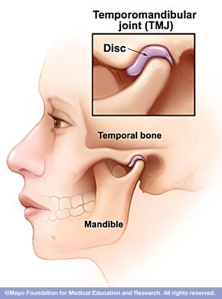
Lately, one of our practitioners Dr Ella Ji has successfully treated a patient with TMJ disorder, the pain in the joint disappeared after one session and the “clicking” sound was much reduced after another two sessions. Here are some information from Mayo Clinic about this condition.
Symptoms
Signs and symptoms of TMJ disorders may include:
- Pain or tenderness of your jaw
- Pain in one or both of the temporomandibular joints
- Aching pain in and around your ear
- Difficulty chewing or pain while chewing
- Aching facial pain
- Locking of the joint, making it difficult to open or close your mouth
TMJ disorders can also cause a clicking sound or grating sensation when you open your mouth or chew. But if there’s no pain or limitation of movement associated with your jaw clicking, you probably don’t need treatment for a TMJ disorder.
Self-management
Becoming more aware of tension-related habits — clenching your jaw, grinding your teeth or chewing pencils — will help you reduce their frequency. The following tips may help you reduce symptoms of TMJ disorders:
- Avoid overuse of jaw muscles. Eat soft foods. Cut food into small pieces. Steer clear of sticky or chewy food. Avoid chewing gum.
- Stretching and massage. Your doctor, dentist or physical therapist may show you how to do exercises that stretch and strengthen your jaw muscles and how to massage the muscles yourself.
- Heat or cold. Applying warm, moist heat or ice to the side of your face may help alleviate pain.
Treatment
Medications
- Pain relievers and anti-inflammatories.
- Tricyclic antidepressants.
- Muscle relaxants.
Therapies
- Oral splints or mouth guards (occlusal appliances).
- Physical therapy.
- Counseling.
Surgical or other procedures
- Arthrocentesis.
- Injections.
- TMJ arthroscopy.
- Modified condylotomy.
- Open-joint surgery.
Alternative medicine
- Acupuncture.
- Relaxation techniques.
- Biofeedback.
To read more, please click here.
